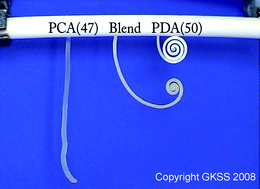Shape-memory capability of binary multiblock copolymer blends with hard and switching domains provided by different components†
Abstract
The structural concept of shape-memory

* Corresponding authors
a
Institute of Polymer Research, GKSS Research Center Geesthacht GmbH, Teltow, Germany
E-mail:
andreas.lendlein@gkss.de
Fax: (+49) 3328-352452
b Freudenberg Forschungsdienste KG, Weinheim, Germany
c Department of Polymer Science and Technology, Tianjin University, 92 Weijin Road, Tianjin, People’s Republic of China
d Sika Technology AG, Tüffenwies 16, Zürich, Switzerland
The structural concept of shape-memory

 Please wait while we load your content...
Something went wrong. Try again?
Please wait while we load your content...
Something went wrong. Try again?
M. Behl, U. Ridder, Y. Feng, S. Kelch and A. Lendlein, Soft Matter, 2009, 5, 676 DOI: 10.1039/B810583A
To request permission to reproduce material from this article, please go to the Copyright Clearance Center request page.
If you are an author contributing to an RSC publication, you do not need to request permission provided correct acknowledgement is given.
If you are the author of this article, you do not need to request permission to reproduce figures and diagrams provided correct acknowledgement is given. If you want to reproduce the whole article in a third-party publication (excluding your thesis/dissertation for which permission is not required) please go to the Copyright Clearance Center request page.
Read more about how to correctly acknowledge RSC content.
 Fetching data from CrossRef.
Fetching data from CrossRef.
This may take some time to load.
Loading related content
